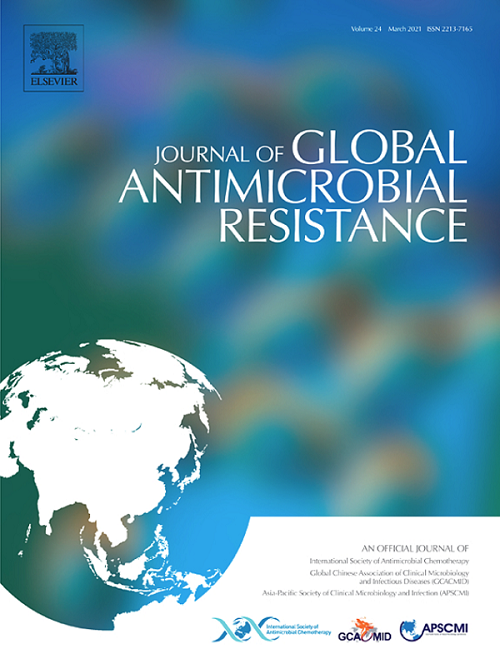头孢双prole对不同遗传型耐甲氧西林金黄色葡萄球菌的活性研究。
IF 3.2
3区 医学
Q2 INFECTIOUS DISEASES
引用次数: 0
摘要
背景:Ceftobiprole于2024年获得美国食品和药物管理局(FDA)批准,并于2013年获得欧洲药品管理局(ema)批准,用于治疗肺炎、细菌性皮肤和皮肤结构感染以及金黄色葡萄球菌血流感染(BSI)。许多耐甲氧西林金黄色葡萄球菌(MRSA)谱系已被确定具有独特的耐药决定因素和毒力因子组合。方法:2018-2019年从bsi采集MRSA分离株150株。进行肉汤微量稀释药敏试验,结果按照美国FDA、临床和实验室标准协会(CLSI)和欧洲药敏试验委员会(EUCAST)指南进行解释。进行基因组测序,确定多位点序列、克隆复合体(CC)、spa和SCCmec类型;分型结果确定克隆组(CG)。结果:总体而言,97.3%的分离株对头孢双prole敏感,而对头孢他林敏感为85.3%,对克林霉素敏感为73.3-74.0%,对甲氧苄啶-磺胺甲恶唑敏感为94.7%,对利奈唑胺、万古霉素和达托霉素敏感为100.0%。ceftobiprole对CC5、CC8和CC22的抑制率分别为97.7%、98.3%和94.1%,而头孢他林对ceftaroline的抑制率分别为84.1%、91.5%和70.6%。只有4株(2.7%)头孢双prole不敏感,而22株(14.7%)头孢他林不敏感;所有不敏感的分离株均来自CC8 (USA500(里昂)和匈牙利/巴西)、CC5 (USA100(瑞士)和USA100)或CC22 (UK-EMRSA-15)内的cg。结论:Ceftobiprole对一组不同系统发育的MRSA分离物表现出比头孢他林更高的活性,可能是治疗MRSA感染的首选广谱抗菌药物。本文章由计算机程序翻译,如有差异,请以英文原文为准。
Activity of ceftobiprole against methicillin-resistant Staphylococcus aureus of diverse genetic types
Background
Ceftobiprole was approved by the United States (US) Food and Drug Administration (FDA) in 2024 and by the European Medicines Agency in 2013 for the treatment of pneumonia, bacterial skin and skin structure infections, and Staphylococcus aureus bloodstream infections. Numerous methicillin-resistant S. aureus (MRSA) lineages have been identified with unique assemblages of resistance determinants and virulence factors.
Methods
MRSA isolates (n = 150) were collected from bloodstream infections in 2018–2019. Broth microdilution antimicrobial susceptibility testing was performed, and results were interpreted by US FDA, Clinical and Laboratory Standards Institute, and European Committee on Antimicrobial Susceptibility Testing guidelines. Genome sequencing was performed to determine multi-locus sequence, clonal complex (CC), spa, and SCCmec types; typing results were used to determine clonal group.
Results
Overall, 97.3% of isolates were ceftobiprole susceptible by FDA and European Committee on Antimicrobial Susceptibility Testing criteria compared to 85.3% for ceftaroline, 73.3%–74.0% for clindamycin, 94.7% for trimethoprim-sulfamethoxazole, and 100.0% for linezolid, vancomycin, and daptomycin. More than 90% of isolates were CC5, CC8, or CC22, and ceftobiprole inhibited 97.7%, 98.3%, and 94.1% of these isolates, respectively, compared to 84.1%, 91.5%, and 70.6% activity of ceftaroline. Only 4 (2.7%) ceftobiprole non-susceptible isolates were identified compared to 22 (14.7%) non-susceptible to ceftaroline; all non-susceptible isolates were from clonal groups within CC8 (USA500 (Lyon) and Hungarian/Brazilian), CC5 (USA100 (Swiss) and USA100), or CC22 (UK-EMRSA-15).
Conclusions
Ceftobiprole demonstrated higher activity than ceftaroline against a phylogenetically diverse set of MRSA isolates and may represent a preferred broad-spectrum antimicrobial choice for the treatment of MRSA infections.
求助全文
通过发布文献求助,成功后即可免费获取论文全文。
去求助
来源期刊

Journal of global antimicrobial resistance
INFECTIOUS DISEASES-PHARMACOLOGY & PHARMACY
CiteScore
8.70
自引率
2.20%
发文量
285
审稿时长
34 weeks
期刊介绍:
The Journal of Global Antimicrobial Resistance (JGAR) is a quarterly online journal run by an international Editorial Board that focuses on the global spread of antibiotic-resistant microbes.
JGAR is a dedicated journal for all professionals working in research, health care, the environment and animal infection control, aiming to track the resistance threat worldwide and provides a single voice devoted to antimicrobial resistance (AMR).
Featuring peer-reviewed and up to date research articles, reviews, short notes and hot topics JGAR covers the key topics related to antibacterial, antiviral, antifungal and antiparasitic resistance.
 求助内容:
求助内容: 应助结果提醒方式:
应助结果提醒方式:


